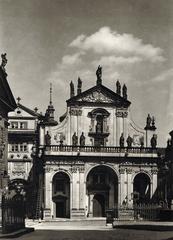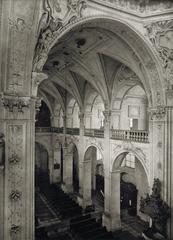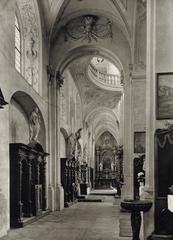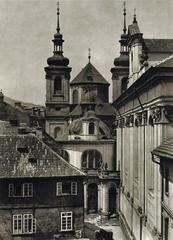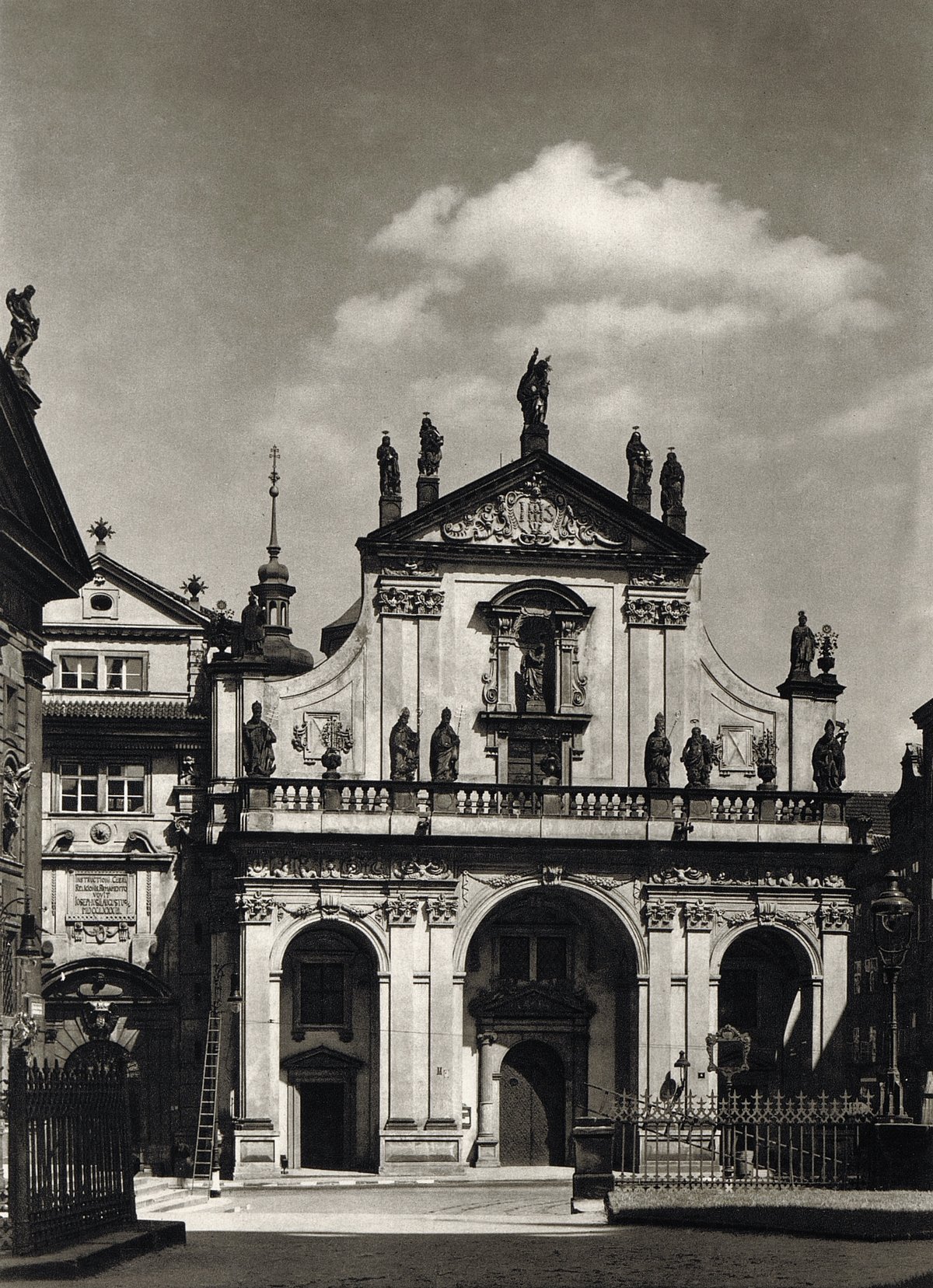
St. Salvator Church, Prague: Visiting Hours, Tickets, and Historical Significance
Date: 14/06/2025
Introduction
St. Salvator Church stands as one of the most significant and visually striking historical landmarks in Prague. Located within the grand Klementinum complex near the Charles Bridge, this early Baroque masterpiece was constructed starting in 1578 and showcases the city’s blend of Renaissance and Baroque architectural styles. Originally built as the principal Jesuit church in Bohemia, it has served as a spiritual, educational, and cultural hub since the Counter-Reformation.
Visitors today are greeted by a harmonious façade adorned with statues of saints and evangelists, and an interior rich with frescoes, stucco galleries, and a renowned organ. Its setting within the Klementinum—one of Europe’s largest historic complexes—connects the church to Prague’s broader intellectual and cultural heritage.
This guide offers essential information for visitors, including practical visiting hours, ticketing, accessibility, special events, and highlights to make the most of your visit. For additional insights, check resources such as Prague Classical Concerts, Life Globe, and Prague Experience.
Table of Contents
- Introduction
- Architectural History and Evolution
- Façade and Sculptural Program
- Interior Design and Artistic Highlights
- Musical Heritage and Organ Concerts
- Jesuit Influence and Symbolism
- Restoration and Preservation
- Visitor Information: Hours, Tickets, and Accessibility
- Practical Visitor Tips
- Frequently Asked Questions (FAQs)
- Conclusion and Call to Action
- References
Architectural History and Evolution
St. Salvator Church marks a pivotal moment in Prague’s architectural evolution, bridging the late Renaissance and early Baroque periods. Construction began in 1578, initially under Marco Fontana di Brusata, with further development in the 17th century by Italian architects Carlo Lurago and Francesco Caratti (Prague Classical Concerts; Prague Ticket Office). The church was modeled after Il Gesù in Rome, which influenced Baroque church design across Europe (Prague Ticket Office).
The exterior features balanced proportions, a grand portico, and a signature lantern tower visible from Charles Bridge (Delve into Europe). The Baroque transformation (1649–1654) added dynamic forms and elaborate ornamentation, hallmarks of this style.
Façade and Sculptural Program
The church’s façade is distinguished by 14 sandstone statues crafted by Jan Jiří Bendl in the late 17th century (Czechology). At the center is Christ the Saviour, flanked by the four Evangelists. Statues of the Immaculate Virgin Mary, St. Ignatius of Loyola, and St. Francis Xavier highlight the Jesuit presence. Statues of Church Fathers on the balustrade reinforce the church’s theological mission (Prague Classical Concerts).
Interior Design and Artistic Highlights
Inside, St. Salvator Church impresses with its spacious three-aisled layout and soaring nave. The dome, richly decorated with frescoes, symbolizes the four continents known at the time—reflecting Jesuit missionary aspirations (Prague Classical Concerts). The marble pavement by Kristina Kortesiová (1660) and elaborate stucco work add layers of artistry (Czechology).
Artistic highlights include:
- The main altarpiece, a reproduction of Raphael’s “Transfiguration of Christ” by Jiří Hering (1632).
- Statues of Czech patron saints and rococo altarpieces in the aisles.
- The painted lantern tower, admired for its natural light and subtle beauty (Delve into Europe).
Musical Heritage and Organ Concerts
St. Salvator Church is renowned for its musical heritage. It houses two impressive organs, including an 18th-century main organ played by celebrated composers such as Jan Dismas Zelenka (Prague Ticket Office). The church regularly hosts classical music concerts, featuring soloists from the National Theatre and Czech Philharmonic (Prague Experience; Prague Views). Its exceptional acoustics make it a premier venue for sacred and classical music (Prague Ticket Office).
Jesuit Influence and Symbolism
St. Salvator Church’s art and symbolism reflect the Jesuit ideals of faith, education, and global evangelization during the Counter-Reformation (Wikipedia). The crypt contains the remains of important Jesuit figures, including Father Antonín Koniáš and Bohuslav Balbín, a defender of the Czech language (Prague Experience).
Restoration and Preservation
Ongoing restoration projects have preserved key features, such as the organs, marble flooring, and stucco decorations. Today, St. Salvator serves as the Czech Republic’s first academic parish and remains a center for ecumenical dialogue (Prague Ticket Office).
Visitor Information: Hours, Tickets, and Accessibility
- Location: Křižovnické náměstí 1040/4, 110 00 Praha 1, Czech Republic (Life Globe)
- Visiting Hours: Typically Monday–Saturday, 9:00 AM–5:00 PM; Sunday 10:00 AM–5:00 PM. Some guides cite 10:00 AM–6:00 PM for sightseeing. Always check the official website or concert schedules for updates.
- Tickets: Free for worshippers; modest fee for tourists. Concert tickets range from 400–900 CZK (€16–€36) and can be purchased online or at the venue (Classictic Prague Guide).
- Accessibility: The church is wheelchair accessible, though some historic areas may have limited access. Assistance is available upon request.
- Guided Tours: Offered in multiple languages by prior arrangement; recommended for deeper historical and architectural insights.
- Nearby Attractions: Charles Bridge, Klementinum complex, Old Town Square, Astronomical Clock, and Prague Castle.
Practical Visitor Tips
- Best Time to Visit: Weekday mornings or early afternoons are less crowded. Arrive early for concerts for the best seats.
- Dress Code: Modest attire is required (shoulders and knees covered), especially for services and concerts.
- Photography: Non-flash photography is permitted outside of services and concerts. Best exterior views are from Charles Bridge or Křižovnické Square.
- Gift Shop: Visit for memorabilia and music-related items (Veronika’s Adventure).
- Climate: The church can be chilly in winter; heated seats are available during services.
Frequently Asked Questions (FAQs)
Q: What are the visiting hours for St. Salvator Church?
A: Generally 9:00 AM–5:00 or 6:00 PM, with possible changes on concert or service days. Confirm on the official website.
Q: Do I need a ticket to enter?
A: Worship is free; tourists pay a small admission fee. Concerts require separate tickets.
Q: Is the church accessible for those with disabilities?
A: Yes, the main areas are accessible; contact the parish for specific needs.
Q: Can I attend concerts?
A: Absolutely, the church regularly hosts classical music concerts—book tickets in advance.
Q: Are guided tours available?
A: Yes, in several languages by prior arrangement.
Conclusion
St. Salvator Church combines architectural grandeur, rich Jesuit heritage, and a vibrant program of spiritual and cultural events. Its location in the heart of Prague’s Old Town, proximity to top attractions, and ongoing community engagement make it a must-visit for anyone interested in history, art, or music. Plan ahead for visiting hours, tickets, and special events to maximize your experience.
Call to Action
For the latest updates on visiting hours, ticketing, and events, download the Audiala app or visit the official website. Explore more Prague historical sites and follow us on social media for expert tips and virtual tours.
References
- St. Salvator Church - Wikipedia, 2024
- Prague Classical Concerts, 2024
- Prague Ticket Office, 2024
- Delve into Europe, 2024
- Czechology, 2024
- Prague Experience, 2024
- Life Globe, 2024
- Classictic Prague Guide, 2024
- Veronika’s Adventure, 2024
- Farnost Salvator Official Website, 2024
